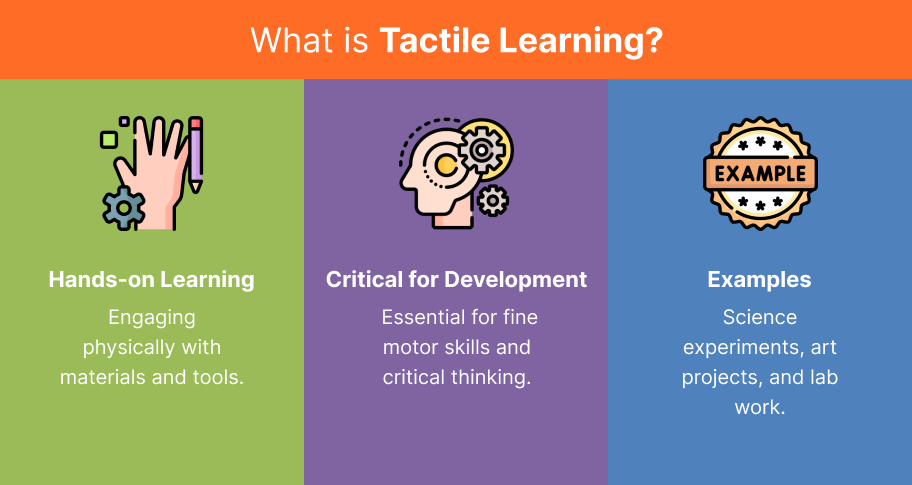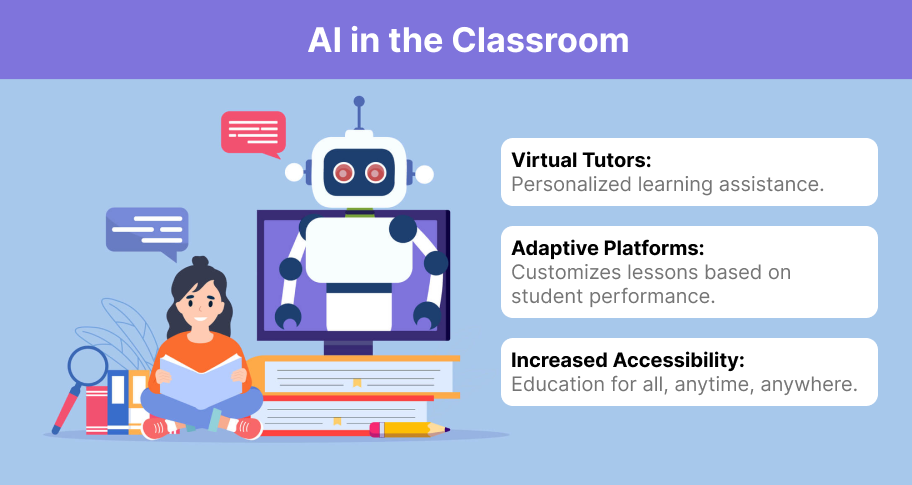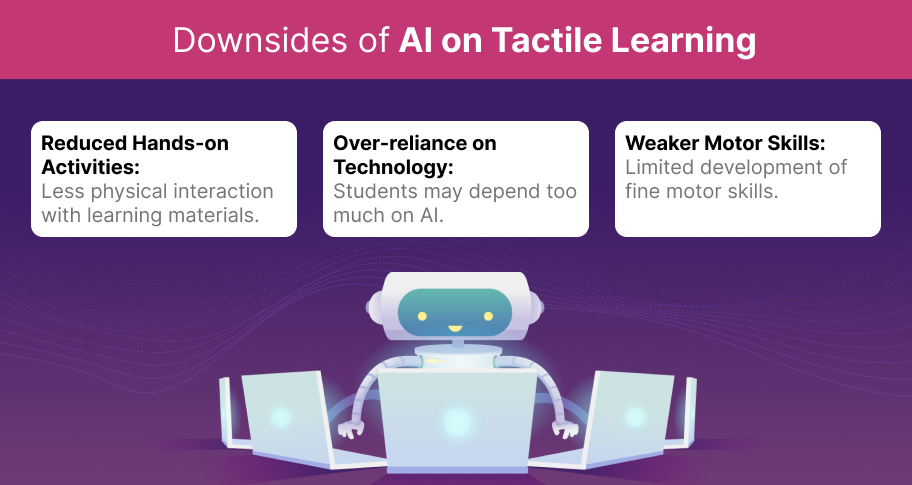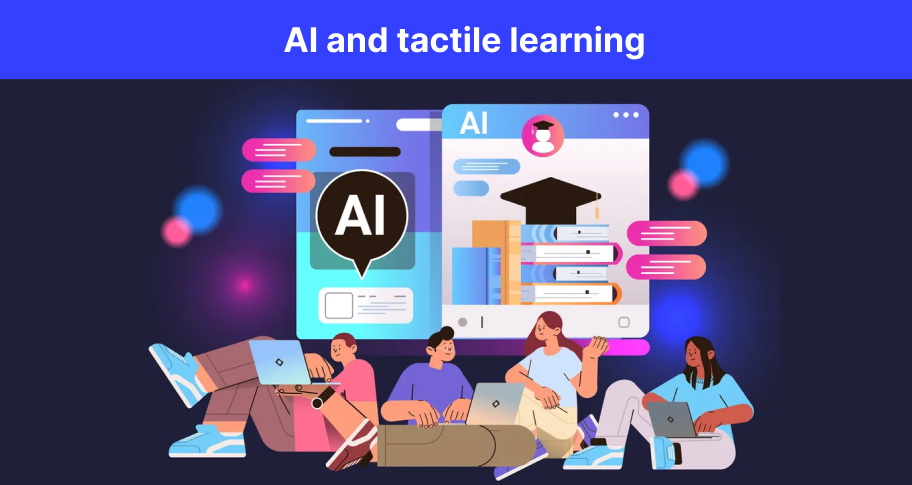Introduction
Artificial intelligence (AI) has finally arrived in force like Arnie in yet another Terminator reboot. AI stocks are flying high on golden promises—as did the previous unicorns in health, EV, and weed sectors of yesteryear. All the tech companies and CEOs are hopping on the bandwagon. Everywhere you look, the AI craze is not just picking up steam—it’s literally blowing as much smoke as it possibly can.
Educators, too, see the latest trends and think about the possibilities. They see AI-powered tools and platforms. They see automated grading and virtual tutors. They see educational bots making their lives simpler. They see a lot less work for themselves and a whole lot of gravy train in the future.
The problem is that too few serious-minded teachers, professors, and administrators are thinking about the negative impacts of AI for high school education and college students.
In particular, almost no one is paying attention to the effects AI can have on tactile learning. AI in education is like a hand grenade about to go off. And it’s going to be a big blow to hands-on, multi-sensory learning if not handled right.
By reading this post, you will explore the dark side of AI and its impact on social interaction within college settings, examining concerns such as reduced face-to-face communication, ethical dilemmas in AI use, and potential implications for student relationships and community dynamics.
Understanding Tactile Learning
What is Tactile Learning
Tactile learning is what’s known as kinesthetic learning—the acquisition of knowledge through physical activities rather than through passive listening or watching. Murphy et al. (2004) put it this way: “Kinesthetic preference refers to learning achieved through the use of experience and practice” (p. 860).
Tactile learning is not just important for little kids—it is also great for older learners (think high school education and college age) because it engages them in hands-on learning tasks that let them gain real-world experience in a controlled environment. The most common examples of tactile learning in school, for example, would be students doing a simulation for their dental course, nursing class, chemistry exam, or engineering assignment. Students touch, handle, feel, manipulate, and experiment with objects and materials.
The importance of tactile learning can be seen in many different ways:
- First off, it enhances memory retention. Physical interaction with learning materials helps to reinforce memory by engaging multiple senses. The more we handle things, the better we get to know it. That’s why one of the most important things a pro quarterback in the NFL can do is get out on the field and get his reps in. Just ask Tom Brady. Tactile learning is like a hot branding iron on the brain: it gets the body to memorize—and it’s the same for everyone, whether tradesman, artist, surgeon, physical therapist, speaker, or instructor.
- Secondly, tactile learning develops fine motor skills. Activities like drawing, feeling, smelling, seeing, squeezing, and using laboratory equipment improve understanding, awareness, dexterity and hand-eye coordination. The more the senses are involved, the deeper goes the lesson. Superficial learning takes place—guess where?—on the surface. Deep down learning is supported by tactile learning—which is like the NAVY SEALS of education. If your education is going to be worth anything, it better involve some degree of tactile learning.
- Third, it promotes active engagement. Tactile learning supports active participation, which makes students more involved and motivated to learn. Active learners are better learners. Better learners get better opportunities. Passive learning teaches one how to be little more than a bump on a log. Real-world success stories are full of active learners who went after it. Active learners need to be actively engaged, and that’s what tactile learning is best at doing.
- Finally, it supports understanding of abstract concepts. Hands-on learning [insert internal link here] makes abstract ideas more concrete and understandable. You can be sitting in the classroom learning about how an engine works, but until you’re actually tearing one apart and rebuilding it with your own two hands, all that information you got isn’t going to be worth a hill of beans. Tactile learning takes the abstract and makes it tangible.
In education, tactile learning really is indispensable for high school and college students. It helps students know, see, understand, and think critically about real-world concepts so that they are ready for real-world work.

The Rise of AI in Education
AI Tools and Applications
Technology’s role in education cannot be ignored. AI is being integrated into classrooms via tools and applications like virtual tutors and adaptive learning platforms. At first glance, these novel solutions might seem like great learning aids. But parents and students should be concerned about AI in education. Why? Because there’s no such thing as a free lunch: short cuts today don’t lead to great outcomes tomorrow. In other words, educational technology can help if it supports tactile learning—but too many AI tools for students do not!
So what are some of these tools? [insert internal link here to tech’s role in education article]
- Virtual Tutors are AI-driven tutors that give personalized assistance by answering students’ questions and guiding them through difficult subjects. However, if they are used too much they can rob students of the experience of learning how to research on their own and make them wholly AI-dependent.
- Adaptive Learning Platforms adjust the difficulty of content based on individual student performance, so that every student gets a customized learning pace. The problem here is that students themselves never learn to adapt to the demands of the real-world, which is certainly not going to adapt for them when they get out into it.
- Automated Grading Systems let teachers streamline the grading processes with quick and easy assessments. What they deny students is the personal and importantly subjective perspective that real people give. It’s called feedback, and students need to learn how to take it because they will be receiving a lot of it from others wherever they end up workwise. Automated grading systems can be useful—but only in moderation.
- Educational Bots are chatbots that assist with administrative tasks, like scheduling or answering common questions. Educators like them because they feel they can focus more on teaching—but the reality is that scheduling and answering q’s is part of teaching, and cutting corners could mean that learners pay down the line.

Benefits of AI in Education
That said, there are some benefits of AI in education. AI advantages include data-driven insights via tools that help teachers identify trends in student performance so they can make data-based decisions to improve learning outcomes. AI tools can also help students with disabilities gain access to education. Automative tools can help teachers with lesson plans and grading—but it is important to remember that time and energy saved by short cuts should be maximized elsewhere to benefit learners.
The Negative Impacts of AI on Education
Reduced Hands-on Experiences
The increasing reliance on AI in education leads to reduced hands-on learning experiences. AI limits physical interaction and hands-on activities in subjects where tactile learning is needed. AI limitations can be seen in the negative impact on science labs and art classes, where AI tools too often replace traditional hands-on activities with virtual simulations, thus denying students the opportunities to learn with real materials.
In subjects like science, art, and physical education, students suffer the most. For example, virtual labs cannot fully replicate the experience of handling real chemicals and equipment in a science lab, and digital art programs cannot substitute the tactile experience of painting or sculpting.
Over-reliance on Technology
Excessive dependence on AI tools causes students to develop an unhealthy dependency on technology. Over-reliance on AI for problem-solving reduces their ability to think critically and on their own. This affects their ability to learn through physical manipulation and experimentation. They don’t learn to trust their own senses or their own judgment. They become totally useless when it comes to the use of human reason. AI-dependency turns students into robots who aren’t ready for the real-world!
View 120,000+ High Quality Academic Documents
Learn-by-example to improve your academic writing
Decreased Motor Skills Development
The decline in tactile learning also directly affects motor skills development. Activities that involve hand-eye coordination and precise movements are needed by students who will specialize in arts and sciences that require fine motor skills development. These skills are absolutely essential for many future professional competencies. AI’s virtual environments lack the physical interaction that allows students to hone these skills. They get no practice in handling the materials relevant to their field. They never learn the form, and enter into the real-world totally lacking any real experience.

Case Studies and Real-life Examples
Examples from Schools and Universities
Several educational institutions have experienced the adverse effects of over-reliance on AI. One high school in La Jolla replaced its traditional science lab sessions with virtual labs. The school wanted to join the AI bandwagon and broadcast it to the world. However, the virtual labs only gave the learners another way to appreciate theoretical knowledge; students still reported a significant loss in understanding experimental procedures and acquiring hands-on skills.
There are many other case studies just like that one. The fact is that real-life examples of AI in schools and AI in universities all tell the same story: too much unreality means lack of preparedness for real reality. Here’s another example: did you know that back before Russia invaded Ukraine many of Wall Street’s most celebrated quants came from Russia? It was because when the Soviet Union collapsed, students had to learn code by writing it out with pencil and paper. They didn’t have AI compiling it for them or software writing large sections of it for them. They had to do it all themselves, by hand, and see how it would all work. As a result, they knew code backwards and forwards—and that’s why tactile learning wins hands-down over AI-driven education every time.
Here’s another case study involving an art class at a Midwestern university. The college had integrated AI-powered art tools into its curriculum thinking this would be a big hit with students. However, survey after survey revealed that many students wanted a return to traditional tactile methods. They struggled with the new media, were underwhelmed by its tailored tutorials, and failed to acquire a true grasp of concepts. Understanding the fundamentals of the course was lost, and the professors all went back to the old tactile ways. There are, in fact, numerous studies on this topic.
Expert Opinions
Educators and psychologists emphasize the importance of maintaining tactile learning even in an AI-driven educational setting. They say again and again that the psychological impact of tactile learning is so much greater, more positive and more beneficial than the kind of passive education that goes on via AI-powered learning.
Expert opinions and educator insights all reveal the significance of tactile learning in high school and colleges across America. One of the reasons so many students in the East are excelling in STEM courses whereas American students are failing is that more tactile learning takes place in the East than here in the West.
Alliance of America has noted that the majority of learners in the US are kinesthetic learners. That means they are hands-on learners and they need hands-on experiences in order to grasp concepts and build on what they receive in classroom lectures and from classroom textbooks. Hands-on learning allows them to engage and process information more fully.
Dr. Sandra Smith asserts, “AI offers personalized learning paths, but it cannot replace the invaluable experiences gained through hands-on learning. Tactile learning is essential for developing a well-rounded skill set. Even the psychological impact of tactile learning cannot be overlooked. It is a style of learning that speaks to the whole learner.”
Psychologist Dr. Remus Hall explains, “The physical interaction involved in tactile learning supports cognitive development and fine motor skills, which are a must for a student’s overall growth. Relying solely on AI can hinder these critical developmental processes.”
View 120,000+ High Quality Academic Documents
Learn-by-example to improve your academic writing
Balancing AI and Tactile Learning
Integrating AI with Hands-on Activities
To address the challenges posed by AI while also not ignoring some of the benefits AI can bring to the classroom, educators should seek to implement a balanced approach. This could be achieved by embracing hybrid learning models and interactive AI tools within a tactile learning environment.
1.Hybrid Learning Models
Hybrid learning models merge the benefits of AI with the irreplaceable value of hands-on experiences. For example, virtual labs can supplement physical lab sessions: this way students have opportunities to experiment in a controlled environment and apply concepts they learned in a digital environment—before applying their knowledge in real-world settings. Students would gain a solid theoretical foundation through AI-enhanced simulations, but they would also benefit from the practical skills acquired in physical labs.
2.Interactive AI Tools
The development and use of interactive AI tools such as augmented reality (AR) and robotics offer a way to blend digital and tactile learning. AR can overlay digital information onto the physical world, which lets students interact with concepts and the real-world simultaneously. Robotics can give hands-on experience in programming and engineering, as students build and robots to solve problems. These tools make learning more engaging and help students think critically.
Overall, balancing AI and tactile learning means integrating technology in education using hybrid learning methods and interactive AI tools. It really is a no-brainer!
Future Directions
The future of education lies with AI and tactile learning integration, bringing both their strengths together and creating a balanced approach that represents all the latest education trends while also addressing the very real learning needs of students.
1.Blended Learning Environments
Future trends are likely to see an increase in blended learning environments that integrate AI and hands-on activities. This will give a holistic educational experience for high school and college students.
Blended learning environments combine the flexibility and personalization of AI with the tangible, experiential benefits of hands-on activities. AI can be used to personalize learning and give real-time feedback. AI can help teachers with tracking student progress so that they can tailor instruction on the fly.
Personalized approaches can help teachers make sure every student can go at his or her own pace and get the support they need in areas where they struggle.
Meanwhile, hands-on activities will still be able to help students develop practical skills and apply their knowledge in real-world contexts. These activities can include lab experiments, collaborative projects, interactive simulations, field trips, immersive experiences, and more.
2.Innovative Educational Technologies
Emerging technologies like AR and virtual reality (VR) have the potential to revolutionize education by creating interactive learning experiences that combine the benefits of AI with the necessity of tactile engagement. AR can bring abstract concepts to life in three-dimensional space. Students can see and interact with complex ideas in a virtual, AI-supported environment. For example, AR can be used in anatomy classes to overlay digital images of organs onto physical models.
VR, on the other hand, can simulate real-world scenarios for hands-on practice in a safe and controlled environment. Medical students can use VR to practice surgeries, and engineering students can use it to explore machinery. These technologies not only make learning more engaging but also help students develop skills and confidence.
AR and VR can also be useful in remote learning, by letting students receive what amounts to hands-on education regardless of where they are physically. This would be particularly helpful in areas with limited access to brick-and-mortar schools.
Conclusion
AI and tactile learning is that integration of AI in education has definitely brought major changes, both positive and negative. One thing is clear, though: the negative impacts of AI on tactile learning include the reduction of hands-on experiences and an over-reliance on technology, both of which can lead to decreased motor skills development and lessened confidence to be able to perform in the real-world.
These challenges show the importance of not letting AI completely overshadow the tactile learning experiences that students need. It must be admitted that AI brings numerous benefits, such as personalized learning, but it is also important to recognize and address its limitations so that a balanced learning experience can be achieved. Now, let’s look at the summary of impacts.
The negative impacts of AI on tactile learning include the reduction of hands-on experiences, over-reliance on technology, decreased motor skills development, and loss of confidence.
AI has uses and benefits in education, but it also has many limitations that affect learning experiences. AI can personalize education through interactive technologies like AR and VR. However, the lack of physical interaction can prevent the development of fine motor skills and practical, hands-on problem-solving abilities.
A balanced approach is needed so that students in high school and college get everything the latest tech has to offer while also being sure to receive indispensable tactile training.
Consider the importance of tactile learning when integrating AI into educational systems. This is a call to action for all educators and policymakers: tactile learning importance must not be underestimated. We should prioritize the integration of tactile learning methods alongside AI technologies to achieve this balanced approach. That way all can benefit from the advantages of AI while not losing the essential elements of hands-on education. And, thus, we can prepare students for a future full of possibility.
Practical strategies include the implementation of hybrid learning models that combine virtual labs with physical experiments, the development of AI tools that encourage physical interaction, the incorporation of AR and VR to create immersive learning experiences, and simulations give students added assistance in understanding. Professional development for teachers could help them better understand how to integrate AI and tactile learning.
Looking ahead, the future of education lies in seamlessly blending AI and tactile learning. Blended learning environments will be the standard going forward. AR and VR will continue to develop and allow for even more sophisticated ways for students to interact with learning materials. Policymakers should support research and development in educational technologies.
Through a holistic embrace of a synergistic approaches that combine the awesome power of AI with the experiential benefits of hands-on activities and kinesthetic learning, we can create a more engaging, more effective, and more personalized learning experience for high school and college students.
The sooner we get started on this endeavor the sooner we can help our kids get prepared for succeeding in the real-world of tomorrow. It’s up to us to support them as much as we can!
Find writing inspiration with our extensive essay library here.

